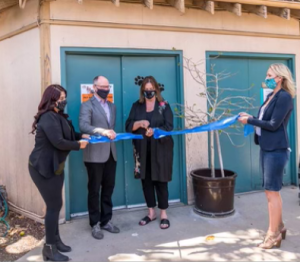
C.A.R.E.4Paws and Santa Barbara County Animal Services (SBCAS) joined forces with five other nonprofit partners to open two new Pet Resource Centers at the County Animal shelters in Lompoc and Santa Barbara. On May 26, Mayor Paula Perotte performed the ribbon cutting at the Santa Barbara shelter, 5473 Overpass Road (pictured). The additional five organizations include: Companion Animal Placement Assistance (CAPA), Animal Care Foundation of Santa Barbara County, ASAP Cats, K-9 PALS, and Bunnies Urgently Needing Shelter (BUNS).
No pet owner should ever have to make the tough decision between paying a bill and buying pet food or providing medical treatment for a four-legged family member. But the pandemic has made it hard for a growing number of community members to care for their pets, leaving animals at greater risk of being relinquished to a shelter. The Pet Resource Centers are part of the shared community-based vision of C.A.R.E.4Paws and SBCAS to leverage partnerships to provide increased support services that prevent animals from ending up in shelters.
Pet Resource Centers are locations where community members can pick up dog and cat food and other supplies, as well as sign up for critical pet wellness services and veterinary care in C.A.R.E.4Paws’ mobile clinic and the SBCAS clinic at the Santa Maria Animal Center.
Beyond the joint Pet Resource Centers, during the pandemic, SBCAS and C.A.R.E.4Paws began collaborating even more closely to prevent animals from being relinquished at SBCAS’s three shelters. A joint staff member works with pet owners inquiring about relinquishing their animals to provide access to the services and support they need to prevent them from having to give up their pet. This includes assistance with spay and neuter surgeries, veterinary care and pet food.
Since the start of COVID-19, C.A.R.E.4Paws’ Companion Pet Assistance program has distributed more than 400,000 pounds of pet food to pet owners in need throughout Santa Barbara County. This amount of pet food is 100 times the total amount of pet food distributed during any year prior to the pandemic and reflects the tremendous need in the community. The uncertainty around the long-term economic impacts of the pandemic creates an imperative to bolster services and resources to keep families together.


